How to make the most of your Teacher membership
Mindomo Teacher is designed for educational personnel who want to help students think critically, investigate and analyze the information they receive.
For Who and Why?
Section titled “For Who and Why?”Educational personnel includes teachers (both specialized and general), librarians, paraprofessionals, and other related personnel who provide educational service. Mindomo Teacher can also be used by parents who choose to homeschool their children for many different reasons.
Teachers who use this subscription can:
- prepare visual lesson plans that include images, videos, and audio materials, etc.
- create assignments to help students acquire critical thinking skills so that they can clearly and objectively understand and explain what they learn
- organize and structure research information and teaching material
- adapt the curriculum to student needs
Librarians can use this subscription to:
- organize, manage and spread information in the academic community
- assist students, teachers, and researchers in their research activities, etc.
Parents homeschooling their children can use this subscription to:
- structure, organize and summarize the researched material in a visual manner
- present the information to be taught and highlight the key points, terminology, etc.
Help students design their learning
Section titled “Help students design their learning”Facilitate Learning for Students
Section titled “Facilitate Learning for Students”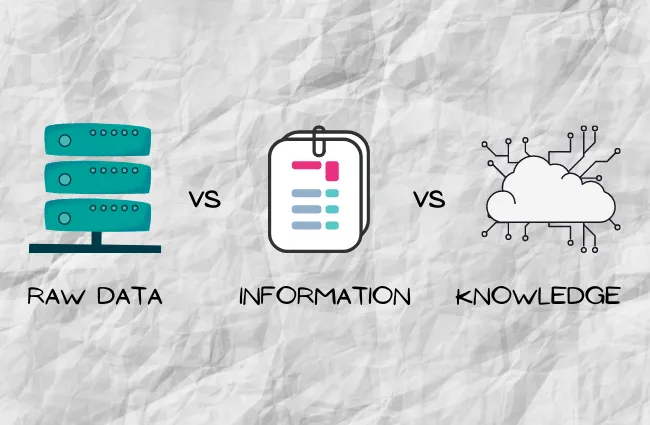
Show students how to think, and you’ll actively involve them in their learning, rather than asking them to memorize the right answers.
Students will put their minds in motion and question things to understand better.
Once you lit their curiosity of always wanting to understand things, students will always seek knowledge instead of data and information.
Autonomy for Each Student
Section titled “Autonomy for Each Student”
Give students the gift of autonomy, therefore helping them think for themselves in uncertain and complex situations in which judgment is more important than routine.
Being autonomous means students will have the intellectual ability to be confident and bold with their ideas rather than to be well organized. As long as they have logical arguments, they won’t be afraid of crossing the conventional line.
Why Mind Maps?
Section titled “Why Mind Maps?”Fit the way our brain works
Section titled “Fit the way our brain works”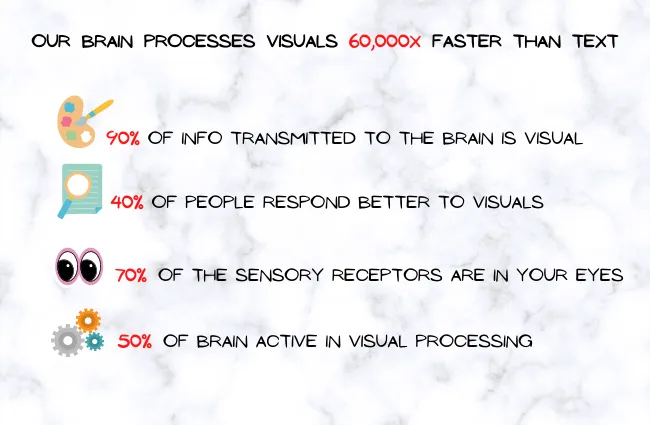
Using mind maps for teaching and learning fits the way our brain works. That sage saying “a picture is worth a thousand words” is backed up by science. Our brains process visuals 60000 times faster than words. Studies also show our brains not only process visuals faster than words but retain and transmit much more information when it’s delivered visually.
Combine right and left hemispheres
Section titled “Combine right and left hemispheres”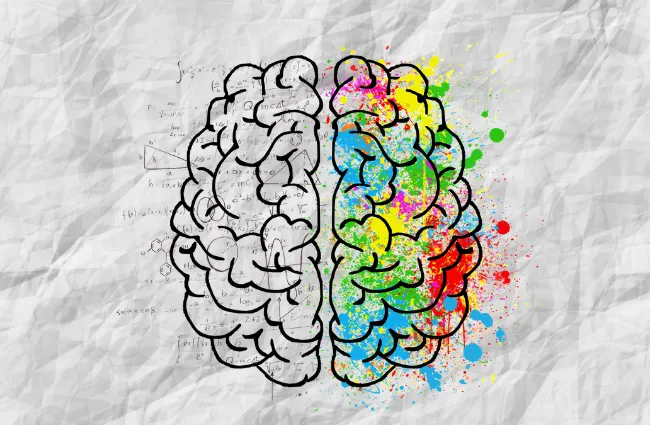
Our brains have two major hemispheres, each with its ways of thinking and processing. The left side is logical, linear, and analytical. The right side is intuitive, creative, and visual. Only by using both sides consistently can students grow personally and professionally.
Mind mapping brings right and left brain hemispheres together. Breaking information into concepts and organizing them hierarchically - left hemisphere. Using shapes, pictures, and colors - right hemisphere. The left brain visualizes the overall image, while the right brain identifies all of the steps necessary to complete the map.
Prompt critical thinking
Section titled “Prompt critical thinking”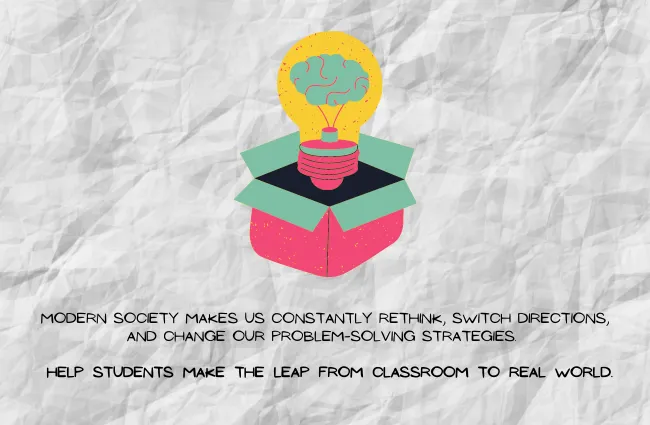
Apart from the visual aspects, the mind map creation process encourages students to develop a healthy questioning and rationalizing attitude.
First, they take the information they know or receive in class and identify the topic or thesis. Then, they break everything into smaller pieces, based on importance and hierarchy. Third, they put their minds to work and look for connections between new information and what they already know.
During the entire time, they will be processing information through synthesis, analysis, interpretation, explanation, evaluation, generalization, comparison, and contrast.
How does Mindomo support learning?
Section titled “How does Mindomo support learning?”Relaxed collaboration
Section titled “Relaxed collaboration”
For the future, when they will likely work and collaborate within a team, students need help to develop soft skills like flexibility, problem-solving, and decision-making.
Mindomo is a highly visual and spatial platform accessible on a desktop, laptop, or mobile device, allowing students to collaborate inside and outside the classroom and beyond the school day. While they work on the same diagram, some students identify key points, and others see the connections and generate new ideas. Having everything organized makes them better prepared, less anxious, and eager to participate.
Inquiry-based learning
Section titled “Inquiry-based learning”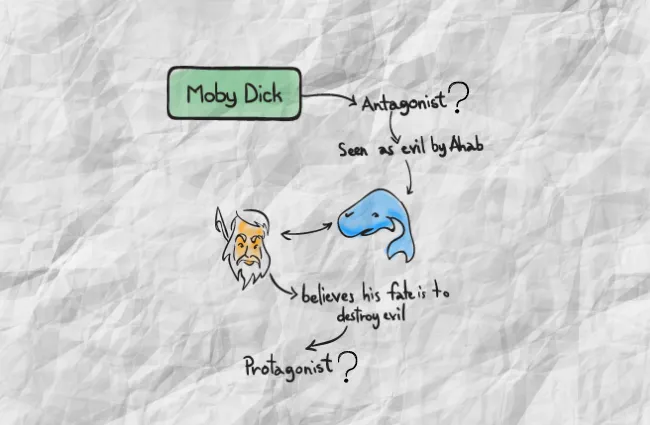
A teacher will be the guide-on-the-side, empowering students to ask questions and find the answers themselves by creating diagrams. While the process might seem messy at times, students learn and understand things at a rapid pace because they aren’t wasting time with what they already know.
Creating diagrams in Mindomo will walk students through all of the phases of inquiry-based learning:
-
Interaction - research different media sources to identify the central topic of the inquiry
-
Clarification - summarizing and categorizing information in a diagram of their choice
-
Questioning - asking relevant questions to drive self-directed inquiry
-
Design - designing an accessible, relevant, and engaging diagram to justify inquiry
Information overload off
Section titled “Information overload off”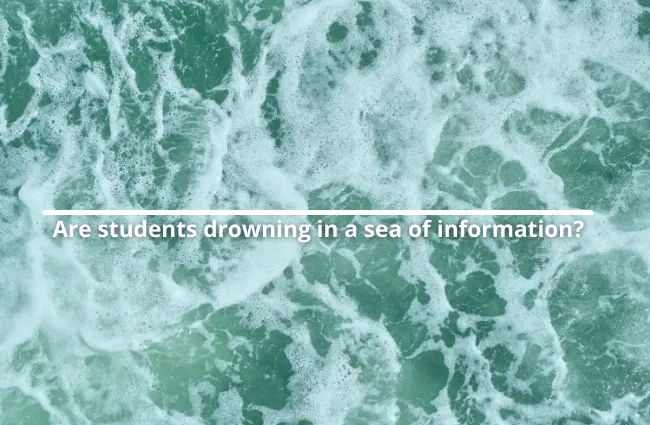
Mindomo lets teachers and students alike visualize complex concepts using all kinds of multimedia - images, symbols, videos, hyperlinks, voice notes, etc.
Creating various diagrams allows students to:
- make information straightforward
- be selective and prioritize key aspects
- put their thoughts down on an infinite canvas where erasing, editing, and reorganizing the content are one click away
Study activities with Mindomo
Section titled “Study activities with Mindomo”Brainstorming Exercises
Section titled “Brainstorming Exercises”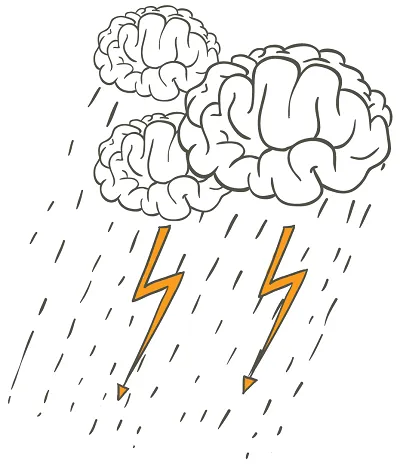
Probably the ideal way to introduce mind mapping to students. There are few to zero rules, all they need is to be spontaneous and write whatever crosses their minds. Students will freely associate ideas to a topic, creatively exploring any path their minds might take.
:bulb: Tips and Tricks
Brainstorming exercises are great icebreakers that you can modify in many ways to make them more fun or more focused:
Blank cluster diagram - ready for use on any topic. Students can freely associate ideas with the main topic.
Brainstorming with cues - guide the brainstorming session by using verbal or visual cues or a combination of both. Share students prefilled concept maps that need further editing. Consider browsing Mindomo’s gallery for an inspiration map template.

Guided brainstorming on specific topics like social and environmental issues, daily activities, argument/opinion essay, cause/effect essay, descriptive/narrative essay, facts and opinions, pros and cons, history, ethics, traveling, cooking, free time, future plans, etc.
Have them create diagrams around open-ended questions. What challenges has WW2 created in the past? What are the best things about being a part of a family? What could your school do better to help you enjoy your experience there? If you had a million dollars, what would you spend it on? What do you like the most about yourself?
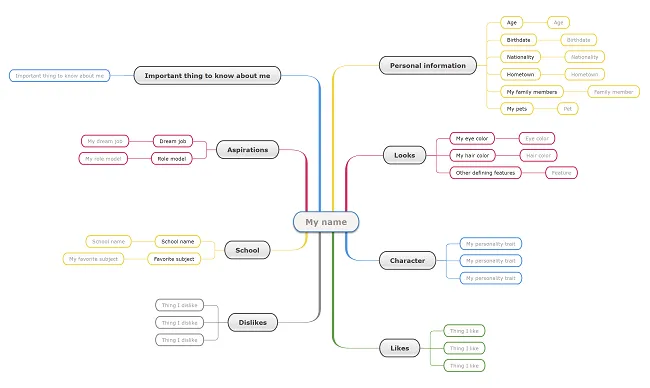
Either alone or in small groups, students should reflect on the questions and create mind maps with the highlights. These maps can make room for more discussions as they are presented in front of the class. Returning to the same questions months later might allow students to show that their independent thinking skills have improved.
Language brainstorming focused on the four basic language skills: listening, speaking, reading, and writing.

Look for inspiration in Mindomo’s templates gallery, for example:
- parts of speech
- nouns
- syntax
- English verb tenses
- collocations
- irregular verbs
- pronouns
- adverbs
- linking words
Integrated Curriculum
Section titled “Integrated Curriculum”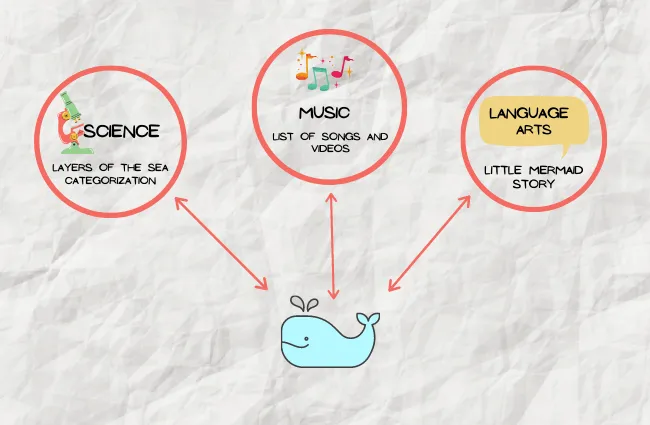
Connect different areas of study by cutting across subject-matter lines and emphasizing unifying concepts. The focus is to make the connections visible and meaningful for students, allowing them to engage in relevant activities that correlate to real life.
For a long time students have been taught subjects in isolation, for example, reading comprehension in Reading classes only, math in Mathematics classes only. But certain math concepts can also be taught in Science classes since the two study areas seem to have a relationship.
Teachers can often integrate history, geography, economics, and government in an intradisciplinary social studies program. Students will show higher signs of retention at an increased rate because they will relate more closely to the content and make real-world connections.
:bulb: Tips and Tricks
Students should highlight the main concepts by using different topic styles for each main subject. For example, red for math, blue for philosophy, green for history.
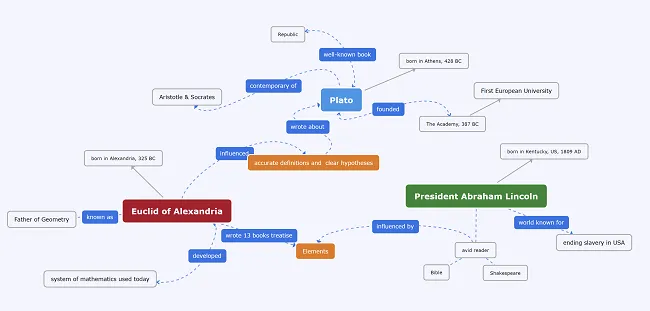
Feel free to use this cross-disciplinary concept map with your students.
Unifying concepts should be emphasized by using the same topic color and shape.
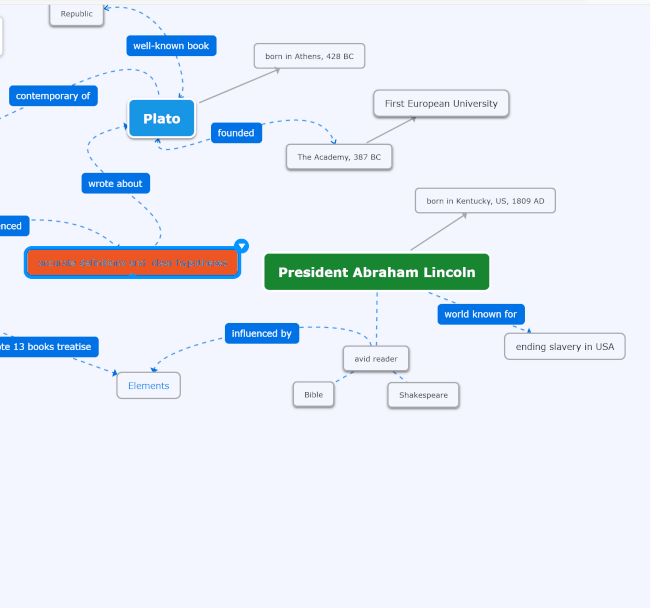
Students should write short explanations on the relationship lines between the unifying concepts to leave breadcrumbs of their reasoning.
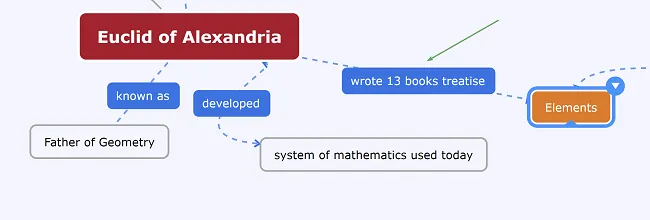

Read more about concept map creation here.
Creative Reasoning
Section titled “Creative Reasoning”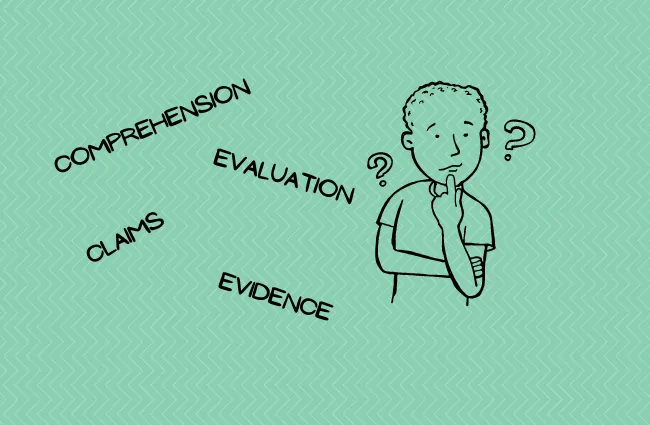
Reasoning is what happens when we take information, we compare it with what we already know and we draw a conclusion. Good reasoning skills favor students’ comprehension, evaluation, and provision of claims and arguments. They are also crucial for students’ ability to generate and maintain coherent viewpoints, justified by relevant knowledge.
In short, students need strong reasoning skills for when they’ll have to make tough choices, distinguish right from wrong, decide how to approach a problem and solve it, etc. Mind mapping will make students’ reasoning visible and worth exploring.
:bulb: Tips and Tricks
To enhance reasoning, ask students to create maps about levels of influence. They should choose an important topic or event, like the late 2000s economic crisis, and put it at the center of the map. Then they’ll need to come up with the events and factors that contributed to that big event.
A topic as complex as the economic crisis requires students to categorize the information they already know, look for anything new, and think about the relationships between causality. When they develop their maps, they’ll always keep in mind cause and effect questions stems.
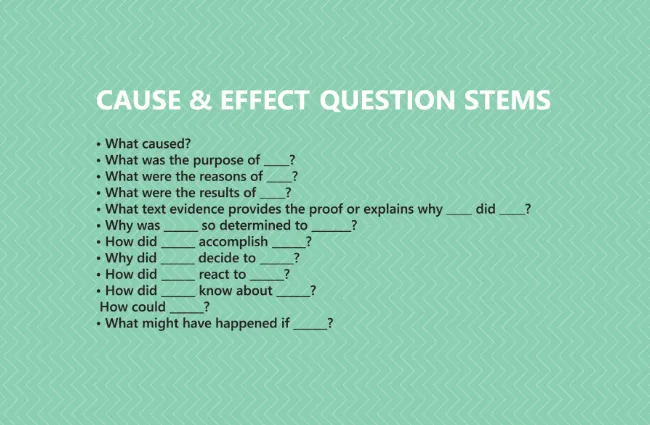
They’ll mind map the first level with the primary impact (causes), then a second level with the secondary impact generated from the first (effects), and so on. They should keep on going outwards and outwards until the map has complete information.
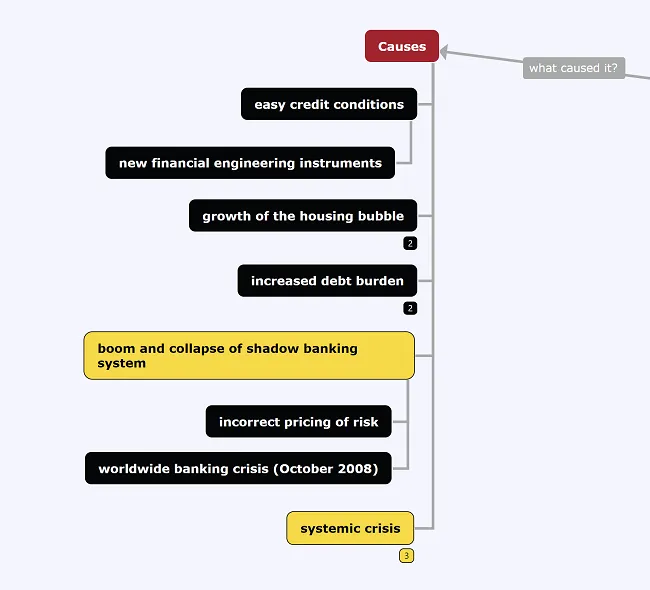

Use this cause-effect mind map example as a starting point.
Essay Writing
Section titled “Essay Writing”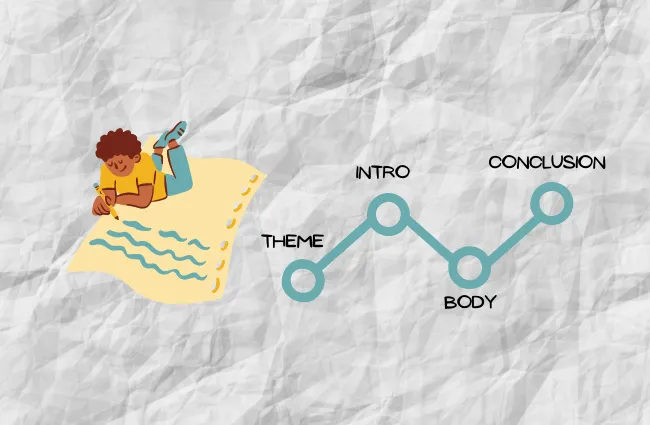
A good essay is structured and organized. It tests students’ most important reasoning skills like analysis, evaluation, and synthesis. Mindomo will guide students to go from the complex to the simple, and draft an essay that is clear and on-topic both for them and their audience.
Advise students to start with a skeleton that contains everything: research, inspiration from other similar essays, pieces of text, etc.
At first, they can dump everything they see fit. Then go through the information twice to reorganize it in a way it makes sense. Use colors and shapes for highlights. The more they become familiar with the topic, the easier it will be to write about it.
In the end, students should aim to create a coherent draft with arguments, counterarguments, examples, quotes, and referenced sources.
:bulb: Tips and Tricks
Use Mindomo’s predefined essay templates as inspiration or ready-to-edit mind maps:
A descriptive essay describes something – an object or person, an event or place, an experience or emotion, or an idea. A student’s goal is to provide the audience with enough detailed descriptions for them to understand the chosen topic.

At any time, the student can turn the mind map into an outline to lay out what they’re going to write:

Editing in the outline view makes writing much easier and brings them closer to the final draft:
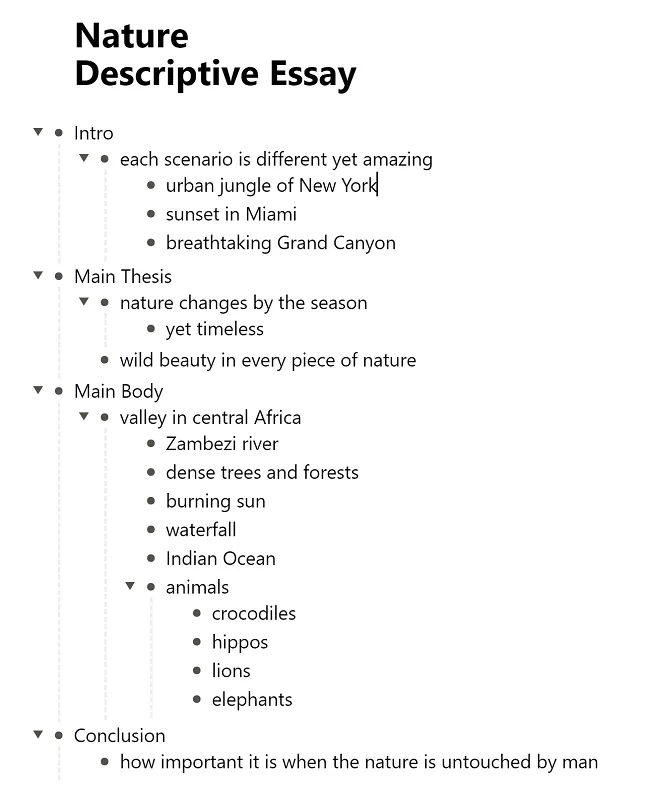
If inspiration strikes, they can write a note for later proofreading:

An argumentative essay uses evidence and facts to support the claim it’s making. A student’s goal is to persuade the reader to agree with their argument. They should use facts and evidence rather than just their thoughts and opinions.
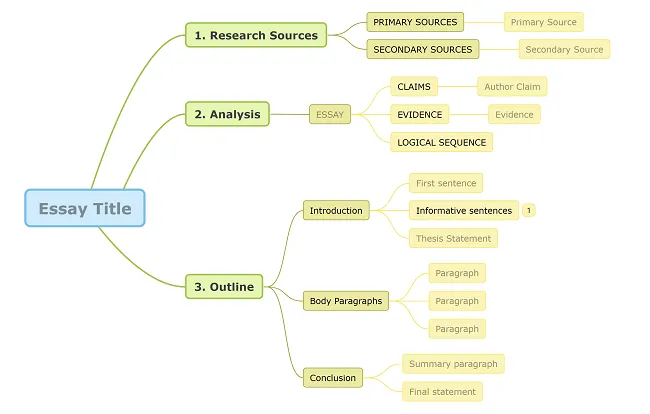
A narrative essay has a single motif, or a central point, around which the whole narrative revolves - all incidents, happenings, and characters. Similar to a simple five-paragraph essay, it has the same format.
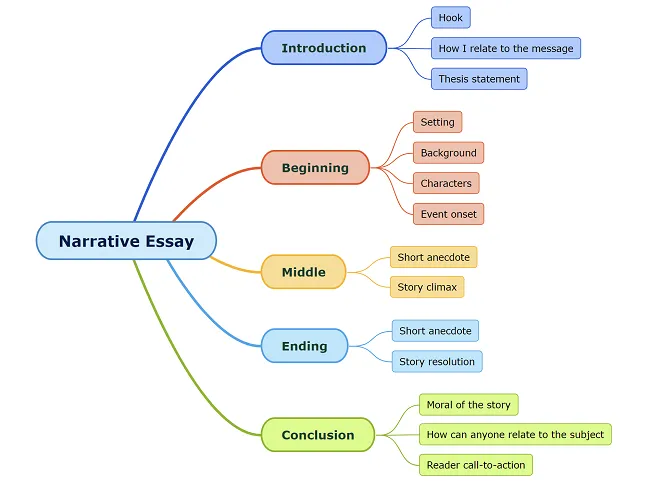
With an expository essay, the goal is to explain, illustrate, or clarify something in a way that becomes clear for readers. Therefore, it could be an investigation, evaluation, or even argumentation about an idea for clarification.
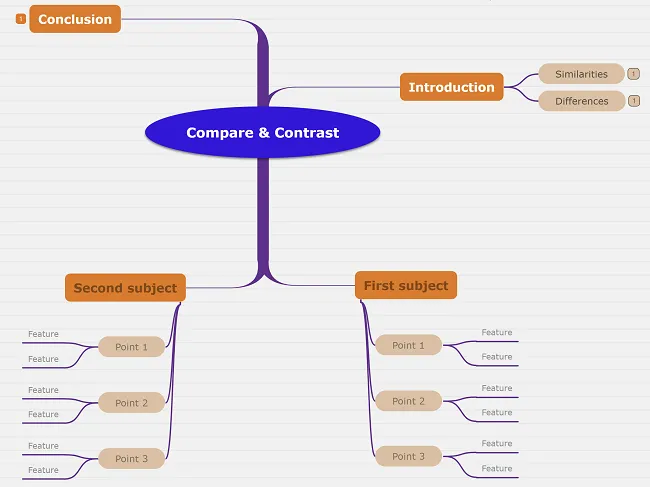
This type of essay makes room for subcategories like:
- cause-effect essays
- problem-solution essays
- compare-and-contrast essays ( similarities-to-differences, point-to-point, whole-to-whole, etc. )
Since any mind map can be turned into an outline, students can write their essays from scratch and print it directly from Mindomo.
Quick Summarizing
Section titled “Quick Summarizing”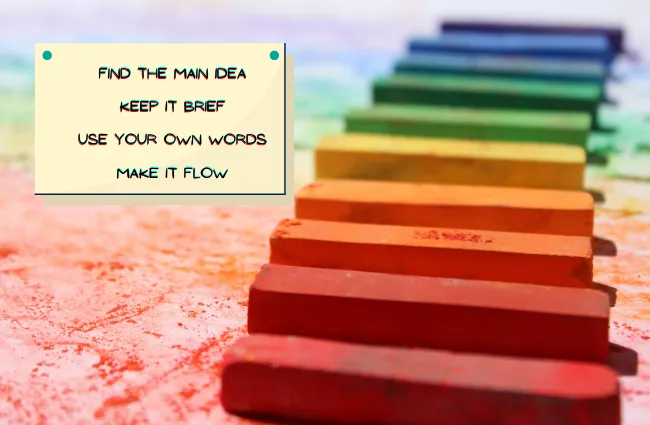
Summarization is good for understanding, retaining, and ultimately recalling information. It can help your students become more purposeful, active readers, thinkers, and learners. If you’d like students to read for knowledge, encourage them to start summarizing with mind maps.
When creating the mind map, students develop a healthy questioning and rationalizing attitude. First, they take the information and identify the main thesis. Second, they break everything into smaller pieces based on importance and hierarchy. Key ideas (chapter numbers, quotes, theories, experiments, author’s writing style, personal opinion about the book, etc.) come as main topics, while the details branch out as subtopics. Third, they start looking for connections between the new information and what they already know.
Using shapes, pictures, and colors will make everything stick in their memory. All books, new or read ages ago, will be easily accessible, anytime, anywhere.
:bulb: Tips and Tricks
Students should draft a descriptive summary to gain and express their understanding of what the author said in the original text. Left and/or right org chart layouts will highlight the cause-and-effect relationship between the main points and supporting details.
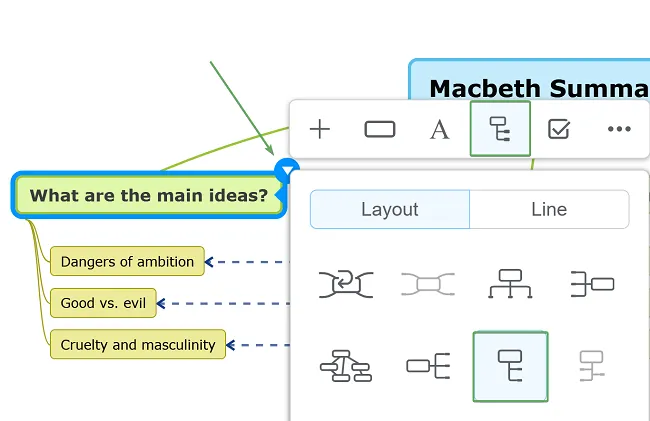
Students should build their diagrams with the following framework questions in mind:

Consider the evaluative summary when students need to examine the original text for usefulness, validity, the strength of argument, etc. This summary is opinion-heavy. Students should list a few basic facts such as the title, author, and the main point of the piece, then focus on their evaluation of the reading. Do they like it or dislike it? Why? Do they agree or disagree with the author? Why? Is the piece well-written?
The right and/or left-sided layouts are a good option for a more organized overview of the information, displaying it in the exact order of the summary structure. Colors and emojis will highlight key details from the evaluation paragraph.

Project-based Learning
Section titled “Project-based Learning”
Project-based learning helps students prepare for their upcoming future where they’ll explore real-world problems, and collaborate with peers to find solutions. Mindomo allows students to work as a team to ideate, brainstorm, and problem-solve. Each student will contribute through ongoing research and input, some of which may occur outside of the classroom and even involve colleagues and teachers from other schools. One can collaborate in Mindomo anytime, anywhere, from any device, all they need is a good internet connection.
:bulb: Tips and Tricks
Set up a collaborative mind map assignment that enables instant sharing of maps between you and your students. You can create the assignment from scratch or choose one of Mindomo’s predefined templates.
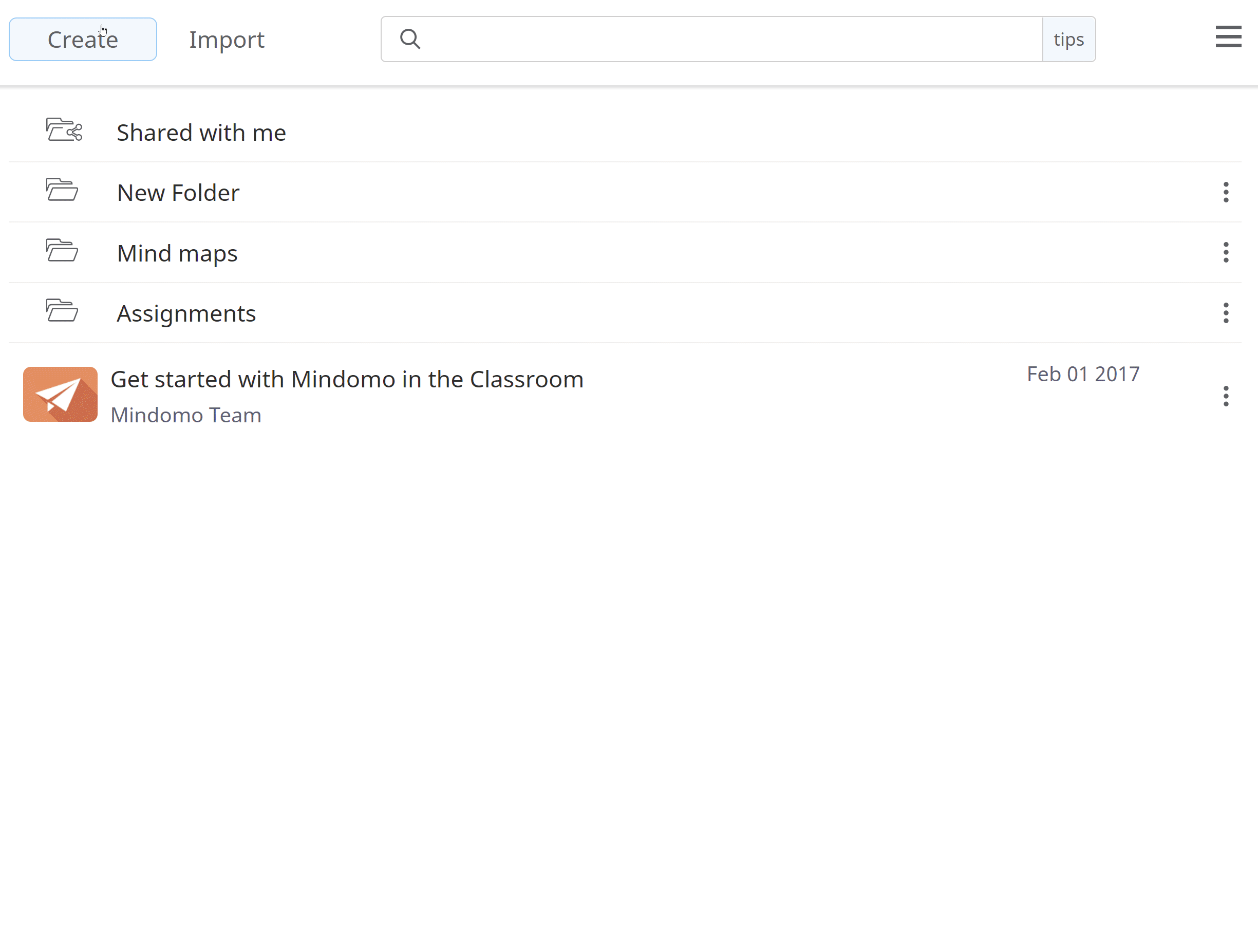
Use the Playback mode to clearly visualize each student’s diagram changes.

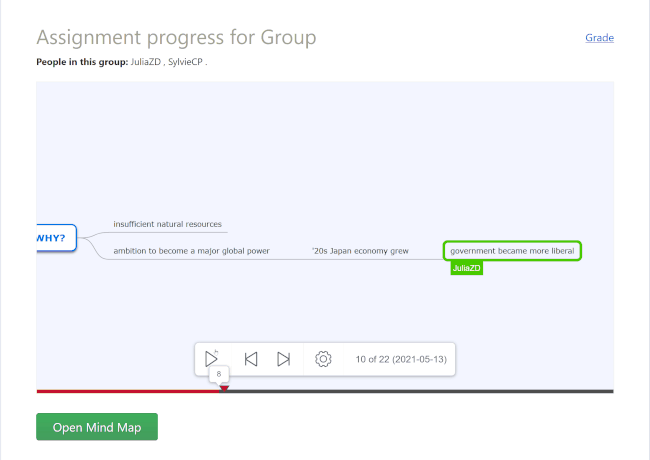
Providing real-time feedback, grading and posting assignment updates are also available.


Speech Preparation
Section titled “Speech Preparation”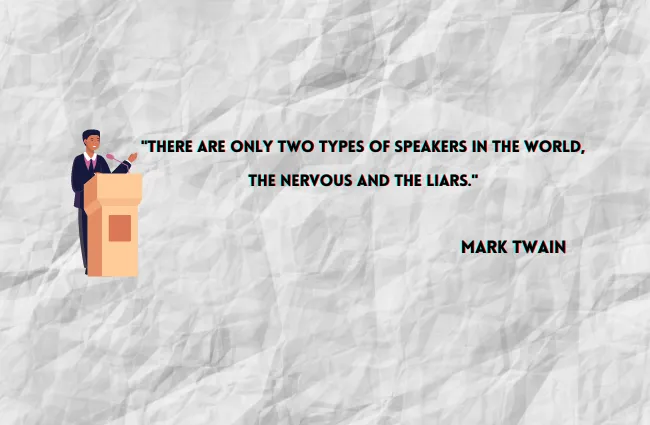
The aim of making or even writing a speech is to convince the audience to support your idea or pay attention to the subject of discussion. Either it’s a speech for their teachers or colleagues, students should focus on building the foundation of good, relaxed speech delivery.
Before drafting their speech, students should try answering these questions: Who are you writing for (the audience)? Why are you giving the speech - what do you want the audience to think, feel, or do in response? What will the speech be about (its topic)? How long should it be ( for example, 3 - 5 minutes)?
:bulb: Tips and Tricks
Right and/or left-sided layouts are a good option to outline key information in a more organized manner. Students should rank the main points in order of their importance and logical sequence in the speech.
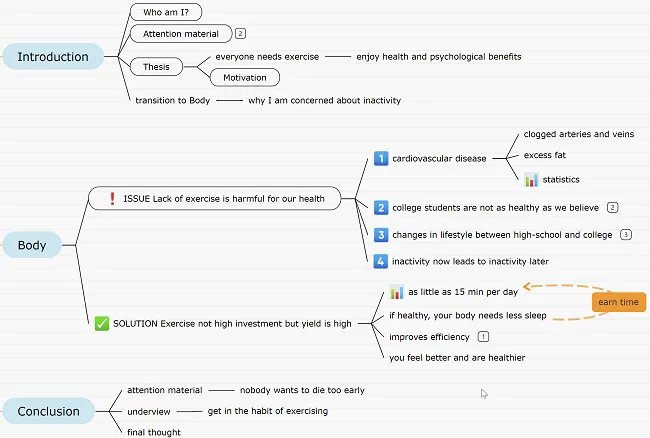
Icons and emojis are ideal for highlighting key aspects - problems, solutions, statistics, explanations, etc.
Advise students to sort out any supporting research that proves their points. Also, they should add videos that help them retain as much valuable information as they can.
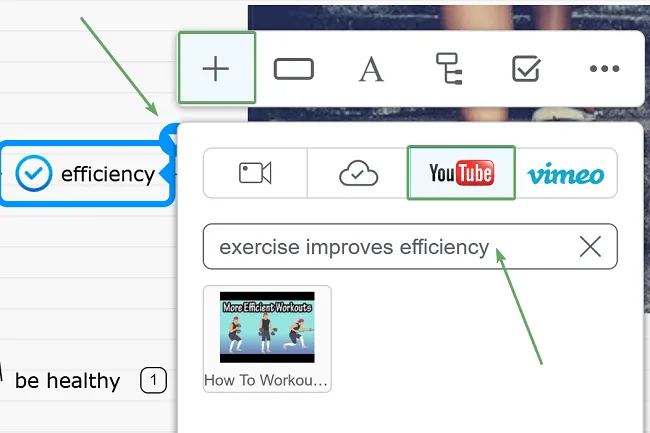
Rehearsing before delivering. At the final review, students can simplify the content, leave only key words and phrases in sight. They can use this simplified diagram as a visual aid for speech delivery.

Turning the map into an outline and printing it as a handout. This way, the audience can use it as a reference as students make their speech.
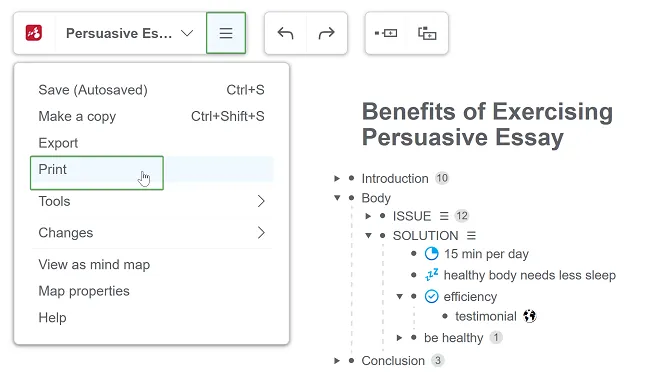
Class Presentations
Section titled “Class Presentations”
Students can make relevant presentations straight from their diagrams and use them to present ideas, projects and assignments in a creative way. This will also be time-saving since they’ll skip the secondary presentation tool and copying and pasting information from one place to another.
:bulb: Tips and Tricks
Easy-to-follow structure (introduction, body, and conclusion) by using either a mind map or a concept map layout.
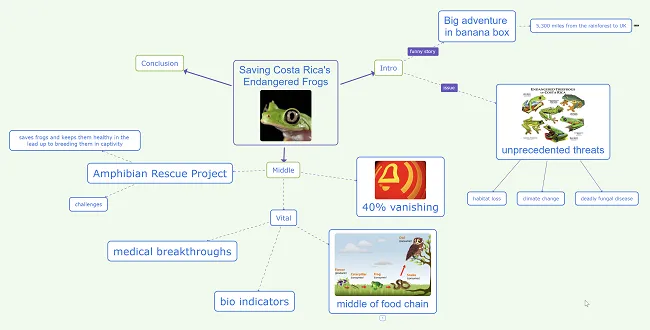
Encourage students to keep their slide deck to 10 slides in total and just six words per slide. This will give the audience a chance to digest the on-screen messages in line with their presentation.

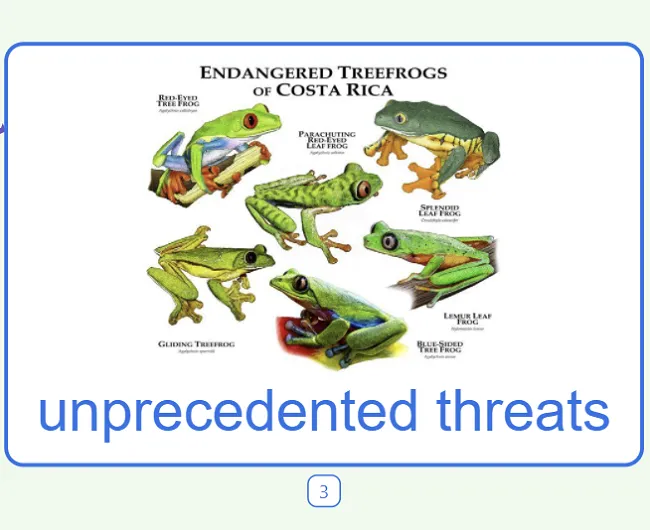
Compelling images and videos will efficiently communicate their ideas and make information easier to remember.
To create a consistent look and feel - 2 or 3 colors only, same font type, size, color, and formatting in all topics. Format for perfection. They can do this with one topic, then use the copy style option to apply the style to the rest of the content.
For a smooth delivery, keep in mind that Mindomo enables the use of a clicker or remote to help students face the audience and not have to keep turning back to their laptops to change slides.
Research
Section titled “Research”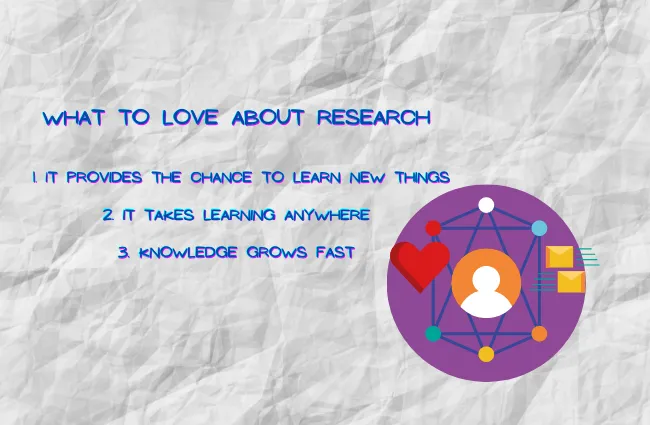
From doing research for any school project to conducting research as an undergraduate, Mindomo can help students:
- foster critical thinking and analytical skills
- expand knowledge and understanding of a chosen field outside the classroom
The kind of research students do will guide the types of resources they’ll need. Visualizing and managing research resources is as important as integrating them into the research process. Resources are usually:
-
Primary sources (original literary or artistic works of actual events - letters, official records, interviews, survey results, etc.)
-
Secondary sources (discussions, evaluations, syntheses, and analyses of primary resources)
:bulb: Tips and Tricks
For book excerpts, brochures, journals, magazines, newspapers case studies, etc., students can either take a photo and upload it, or create hyperlinks to their location on the web. They can add the hyperlink to a word or phrase or add it as a topic attachment.
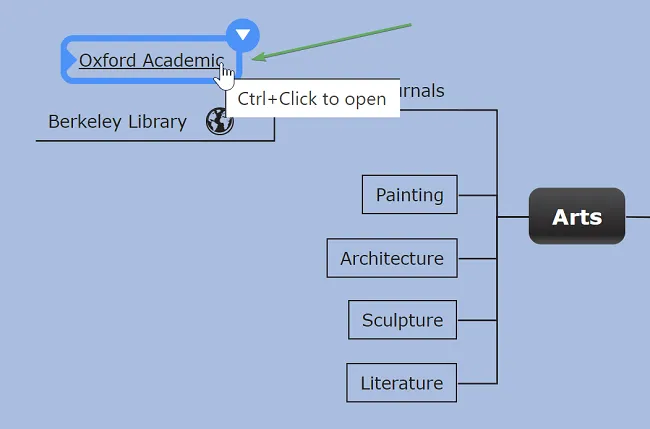
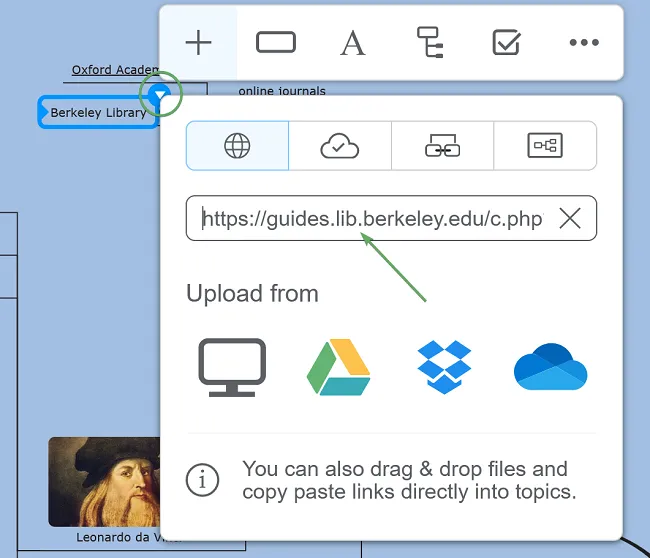
Students can use any of their saved Mindomo Bookmarks (text, links, images) relevant to research:
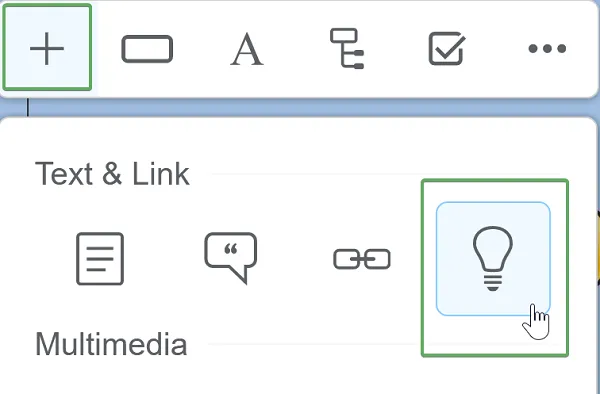
Copying and pasting info from one map to another (including links, images, notes, and other resources) is a time-saving feature. Read more about it here.
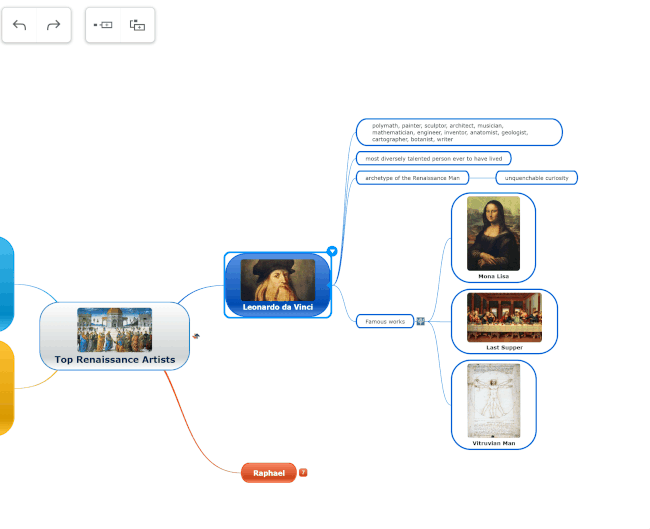
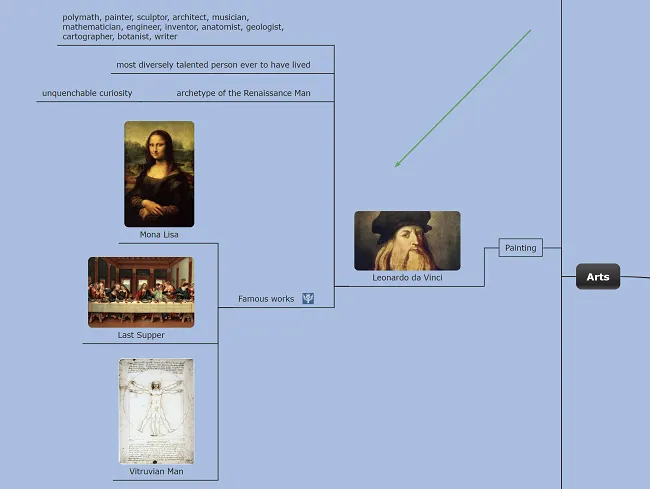
Note creation to keep larger bodies of text hidden from the big picture, for example, long book excerpts. Students can go over the details if needed without losing their focus.
If they collect research data through observation or experimentation, they should consider adding personal audio files and even record their speech directly in Mindomo.
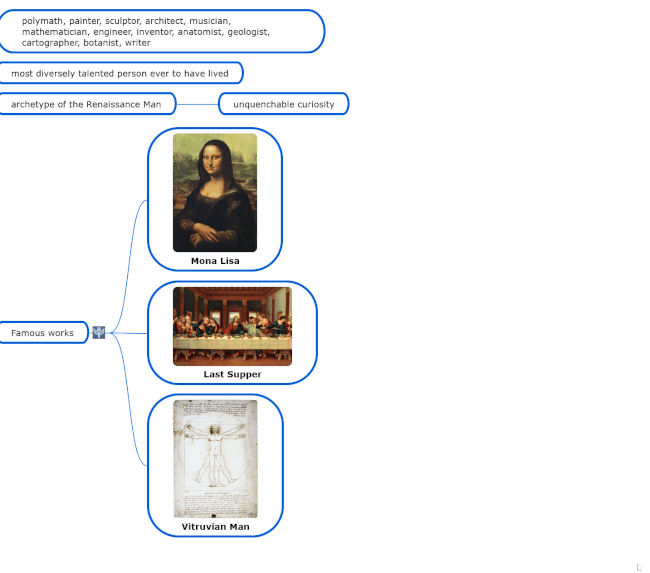
At any point, no matter how complex the diagram becomes, they can quickly find specific content using Search and Filter options.
Inquiry Process
Section titled “Inquiry Process”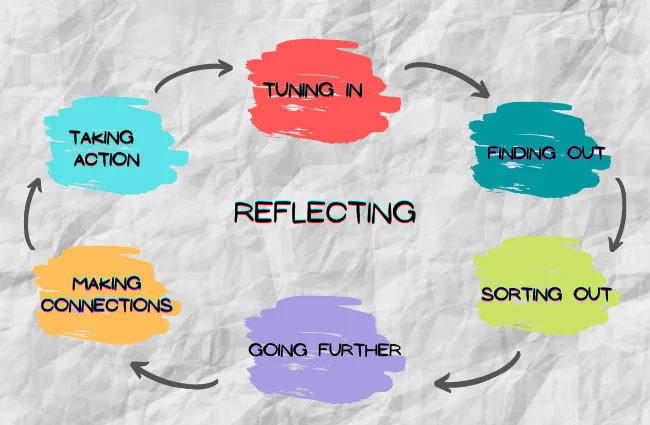
The inquiry process allows students to approach problems intuitively. Generally, this process involves four steps:
- Understanding the problem
- Making a plan
- Carrying out the plan
- Looking back to check the results
Teaching through the inquiry approach is beneficial because it:
- creates an environment that stimulates cooperative learning
- increases students’ engagement and sense of responsibility for their own learning
- helps students to engage prior knowledge
- has cross-curricular links
- creates opportunities for peer evaluations and constructive feedback
Creating diagrams will give students the appropriate frameworks to construct their knowledge and explore ideas, questions, research, resources, findings, and solutions.
:bulb: Tips and Tricks
Encourage students to create diagrams using mathematician George Pólya’s four-step model. Trying various layouts will help students decide which has the best visual impact on them:

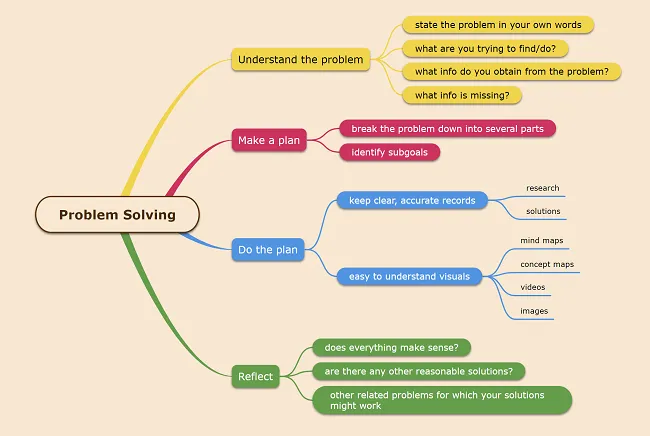

Feel free to use in class this problem solving mind map as a starting point.
Customizing the diagram and adding the resources they see fit gives students the flexibility to construct their knowledge.
Sharing diagrams with colleagues and teachers will expose students to the strategies used by their peers.
Teacher activities with Mindomo
Section titled “Teacher activities with Mindomo”Daily Routine
Section titled “Daily Routine”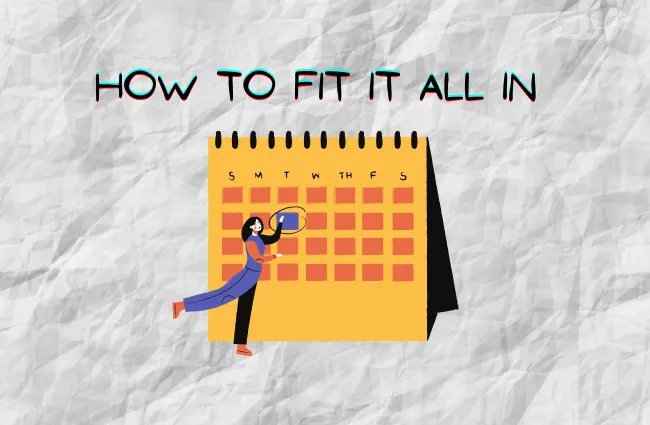
The teaching context might be very different from one teacher to another, but there are challenges that almost all teachers can relate to:
- how to maximize morning time before school starts
- how to get things done during planning time with only 20 minutes available
- how to wrap up the day when there are 30 things to be done and exhaustion kicks in
Diagrams can be used as springboards to figure out how to streamline, simplify, and maximize your time.
:bulb: Tips and Tricks
Create a vivid work framework having in mind all your to-dos and the best way to prioritize them:
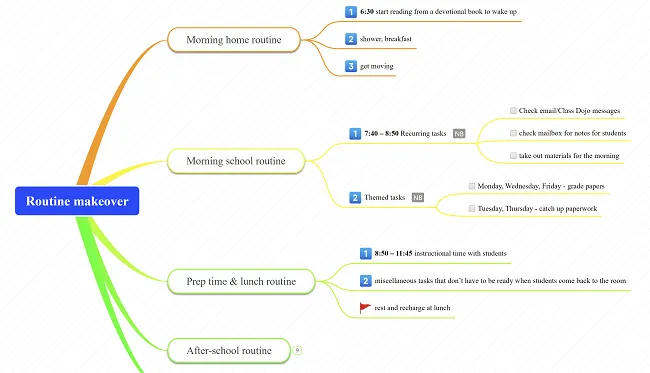
Get started with this daily schedule mind map.
Focus on what needs to be done to achieve more in less time. Self-assign tasks that you can later check off to visualize your progress.

Use emojis to highlight priorities:

Curriculum Design
Section titled “Curriculum Design”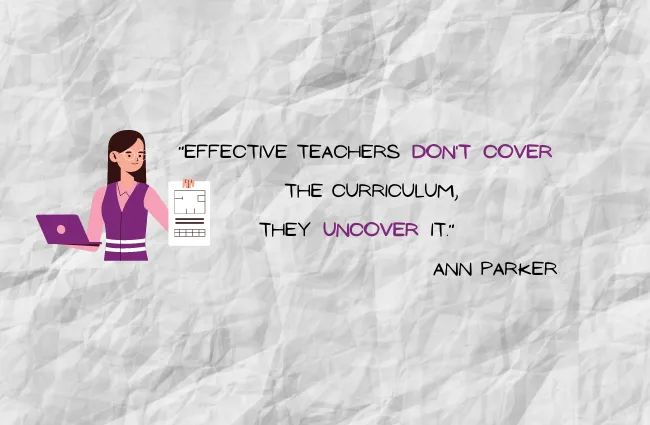
Curriculum planning means making decisions about what is to be learned, why, and how to organize teaching and learning taking into account existing curriculum requirements and the resources available.
Diagramming is an efficient method to present the units you will cover, key concepts that provide a vehicle for inquiry, and related concepts that would provide depth and detail.
:bulb: Tips and Tricks
Create lively diagrams and share them with colleagues. This way, you can involve a team with significant knowledge and understanding of the student to determine the most appropriate curriculum options.

Use this curriculum mind map and adjust it to your specific needs.
Course Overview
Section titled “Course Overview”
The course overview introduces the course and provides the course structure and its approaches to learning. The basic elements include:
- what topics will be covered
- course objectives
- weekly schedule
- teaching methods and media
- list of tests, assignments, and associated weightings
Software diagrams are as visual and accessible as it gets in terms of organizing and sharing syllabus-related information with both colleagues and students.
:bulb: Tips and Tricks
Be student-centered, rather than teacher-centered or course-centered, and keep it simple, concise, and visually pleasing.
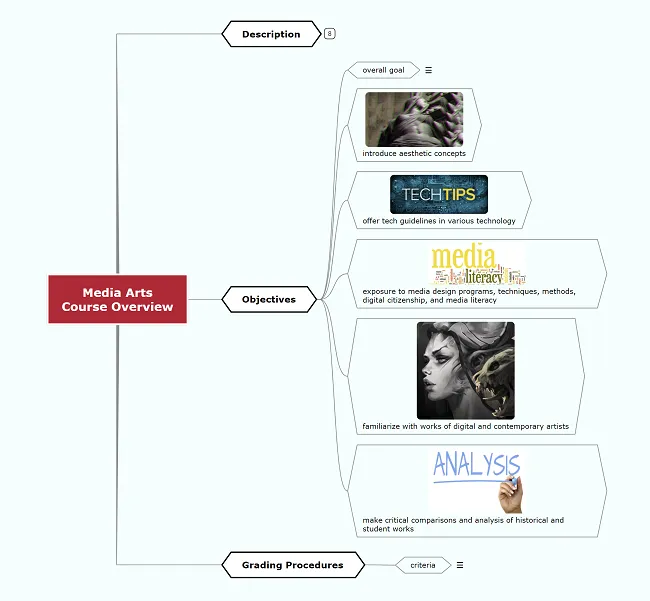
Check out this course overview mind map.
Create notes to detail significant information like evaluation criteria, course policies, grading procedures, etc.
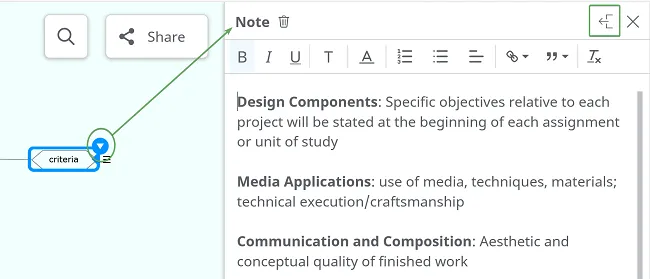
Share it as a mind map, concept map, or even an outline.
Cross-curricular Collaboration
Section titled “Cross-curricular Collaboration”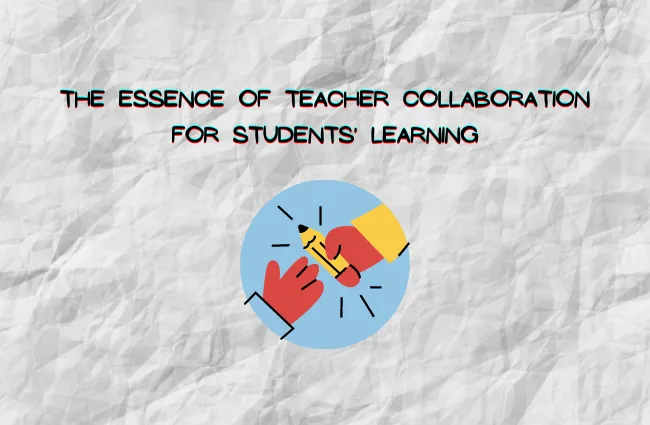
Join colleagues to create opportunities for students to engage in more meaningful learning while improving their communication, critical thinking, and problem-solving skills. Leverage mind mapping to exchange information, fuel peer engagement, and creativity.
:bulb: Tips and Tricks
Find a common bond between your class and that of a colleague and start collaborating. If you are using project-based learning (PBL), you can share that framework with a colleague asking for input.
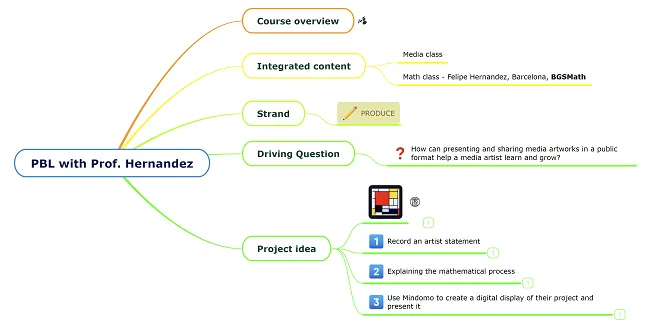
Feel free to use this PBL mind map as a starting point for your own diagram.
You can create collaborative assignments where students from both classes connect and share knowledge altogether with backgrounds, interests, and other facts about their lives.